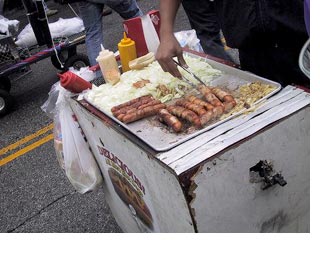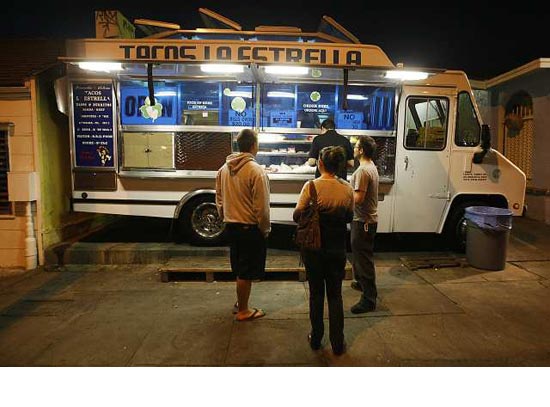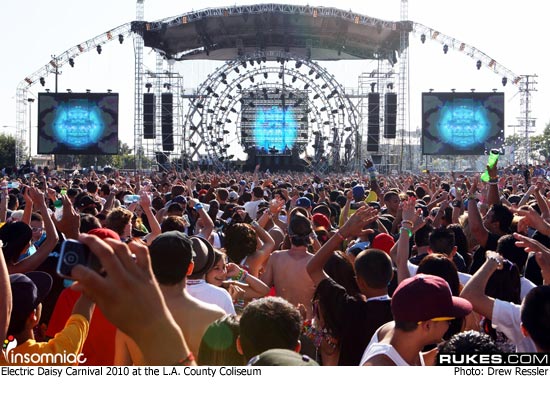Public Health
A new tack on raves and drugs [updated]
November 9, 2010
At 63, John Viernes admittedly didn’t blend into the crowd. For one thing, he was wearing more clothes.
But there he was, director of Los Angeles County’s substance abuse and prevention office, positioned at the entrance of the Sports Arena, handing out 3-by-5 cards about the drug Ecstasy to the throngs at last month’s Monster Massive electronic music festival.
“This is really cool,” Viernes says he was told by a number of concertgoers, who actually kept the material. That included the scantily clad girl who gave him a high-five.
The cards—among dozens of recommendations offered this week by a task force on “rave” safety—represent a departure of sorts for the public health department as it experiments with a more credible way to connect with and influence its target audience.
The glossy, colorful cards carry the inherent message that public health officials know that some concertgoers are going to take Ecstasy and want to help them “minimize potential harms” by offering guidance on, among other things, the signs of an overdose, how to keep properly hydrated and the potentially lifesaving importance of keeping doses low and infrequent.
Viernes said some attendees seemed taken aback by the county’s open-minded approach. “I told them to read all the way to the bottom,” Viernes says, where the cards (which were funded by concert promoters) state: “The only way to completely avoid the risks is to avoid the drug, enjoy the music and dancing instead.”
Since the overdose death last summer of a 15-year-old girl who’d attended the annual Electric Daisy Carnival at the Coliseum, these huge electronic music festivals have come under intense scrutiny from health and public safety officials. Emergency room doctors have said that they prepare for concert nights as they would for such “multi-casualty incidents” as earthquakes because of the number of Ecstasy overdoses. Some critics called for an outright ban of raves at public venues, which reap considerable income from renting their facilities to concert promoters.
In the wake of the Electric Daisy Carnival, which drew a stunning 185,000 people during its two-day run in June, the Board of Supervisors unanimously approved a motion by Supervisors Zev Yaroslavsky and Don Knabe to create a task force comprised of public and private sector representatives to take a deeper look at the issues and come up with ways to enhance safety and educate the public on the perils of Ecstasy, a synthetic amphetamine that has become the drug of choice among a growing number of young teens.
In fact, last year the Los Angeles Unified School District sent an “information alert” to principals warning of a “sharp rise in the incidents of ecstasy use in our middle schools and high schools” that led some campuses “to call paramedics for students passed out at school.”
On Monday, the task force submitted to the board 42 recommendations encompassing such areas as emergency medical services, health precautions, law enforcement activities, alcohol policies, venue restrictions and public education campaigns. Participants, including concert promoters, have praised the effort for getting everyone in the same room and giving the issue the high priority that it deserves.
In a statement, a spokesman for Electric Daisy Carnival promoter Insomniac said: “We look forward to implementing these recommendations, in conjunction with Insomniac’s existing safety and security measures, to enhance the safety of events throughout the county while preserving the quality and fun of music fans’ experience.”
Already, some of the recommendations have been piloted at two festivals at the Sports Arena, where the crowds are a fraction of those at the Coliseum. Perhaps most significant for the moment, no one under 18 was allowed to attend the events and a medical station with a physician and nursing staff was set up inside the venue.
Cathy Chidester, director of the county’s emergency medical services agency, says the medical station eliminated the need for many people to be transported to overburdened emergency rooms, a significant change from the past.
Chidester, who attended the last two raves at the Sports Arena, says roving paramedics and emergency medical technicians brought a variety of ailing concertgoers to the physician, most of whom were “slightly altered and needed to be watched until the drug levels [in their systems] went down.” In the past, she says, these people would be transported to hospitals.
Meanwhile, outside the arena, another substantial change had taken root: the number of Los Angeles Police officers deployed in the parking lot had soared to 450 from the 250 assigned to the Coliseum’s Electric Daisy Carnival.
LAPD Deputy Chief Patrick Gannon says most everyone on the task force wanted to keep the raves alive so people could enjoy themselves. “But I don’t want to sanction a drug party either,” says Gannon, who is not happy about using officers “who are normally patrolling the streets of South L.A.”. The goal, he says, is to deter gate crashers and try to shut down drug sales outside so it becomes less problematic on the inside.
Because of the burden on the system, Gannon says he thinks concert promoters should be forced to pick up the tab. “I’ve had conversations with Councilman [Bernard] Parks. We don’t come close to agreeing.” Gannon says the former LAPD chief “thinks I over-deploy. I respectfully disagree. It’s been a long time since he’s deployed officers.”
Parks says he does, in fact, believe that deployment levels at the electronic music festivals have been disproportionate to the problems. He says Gannon’s desire to dry up parking lot drug sales is commendable. “But he should probably call in the Sheriff’s Department, the National Guard and the military if that’s his goal. There’s been drug usage at concerts since before his birth.”
Parks says that festival promoters at the Coliseum and Sports Arena should not be forced to pay for unnecessary officers outside the facility. “The fact that they [LAPD] have chosen to over deploy is on their dime not the dime of the promoter.”
Meanwhile, work continues on the educational component of the campaign. A public service announcement on the dangers of Ecstasy is being prepared for airing at venues and possibly on ticket services.
Financed by promoters, it’ll include such big-name DJ’s as Will.i.am and Tommie Sunshine, who looks into the camera and says: “Rolling on Ecstasy can cause heart problems, brain damage, stroke and possibly death.”
The task force, led by Public Health Director Dr. Jonathan E. Fielding, is asking the Board of Supervisors to adopt the recommendations as “general policy direction” for electronic music festivals countywide and to encourage promoters and sponsoring entities to get on board, too.
Posted 11/9/10
Updated 12/7/10: The Board of Supervisors, acting on a second motion by Supervisors Yaroslavsky and Knabe, unanimously adopted the task force’s key recommendations as general policy direction for all electornic music festivals in Los Angeles County. Those key recommendations include, among other things, ensuring the presence of onsite medical and health personnel, requiring attendees to be 18 or older, creating a threat assessment and action plan for each event and distributing harm reduction materials to concertgoers.
The board also directed the Department of Public Health to report back by the end of September, 2011, with an evaluation of the succcess or failure of health and safety measures implemented at all major electronic music festivals in L.A. County between June of this year and August, 31, 2011.
Getting the lead out for healthy kids
October 29, 2010
 If you haven’t checked your home for sources of lead exposure, this would be a good week to start. The county Department of Public Health, in observance of National Lead Poisoning Prevention Week, is putting out the word about common sources of lead that can cause health problems, especially for children. The main cause of lead poisoning in Los Angeles County children is exposure to peeling lead-based paint, which is commonly found in houses, apartments, and buildings built before 1978. Other sources of lead exposure include contaminated ground soil, lead dust from work clothes, folk remedies like Azarcón and Greta, and imported toys and candy.
If you haven’t checked your home for sources of lead exposure, this would be a good week to start. The county Department of Public Health, in observance of National Lead Poisoning Prevention Week, is putting out the word about common sources of lead that can cause health problems, especially for children. The main cause of lead poisoning in Los Angeles County children is exposure to peeling lead-based paint, which is commonly found in houses, apartments, and buildings built before 1978. Other sources of lead exposure include contaminated ground soil, lead dust from work clothes, folk remedies like Azarcón and Greta, and imported toys and candy.
“In 2009, 671 children in Los Angeles County had seriously elevated blood-lead levels, which is entirely preventable,” said Jonathan E. Fielding, the county’s director of public health. “Lead can seriously affect a child’s brain and nervous system and may cause learning and behavioral problems.” A blood lead test is the only way to identify and confirm elevated lead levels in children.
Parents who are concerned about their children’s exposure to lead are urged to ask their child’s doctor about lead testing. Free materials in many languages, as well as answers to questions on lead poisoning prevention, are available by calling 1-800-LA-4-LEAD or online here. Parents who do not have a doctor for their child can also call the hotline for referrals to free and low-cost health services for children and teens.
Posted 10/29/10
Some restaurant ABCs are MIA
October 13, 2010
As neighborhood cafes go, Julienne would seem to have it all—a charming setting in upscale San Marino with hordes of loyal patrons who throng the sidewalk waiting for a table at breakfast or lunch.
Julienne also has one of L.A. County’s most important food preparation status symbols: an “A” from the public health department. But you wouldn’t know it by looking in the café’s window.
Letter grades—displayed in restaurants and markets throughout Los Angeles County and soon to be posted on food trucks—are nowhere to be seen in San Marino. The same goes for Avalon, La Habra Heights, Sierra Madre and Signal Hill.
For Terrance Powell, those cities are the ones that got away.
Since the restaurant ordinance went into effect in 1998, Powell has been the public health department’s man on the front lines of getting municipalities within the county to adopt the law. Over the years, virtually every city with food-serving businesses has gotten onboard (with the exception of Pasadena, Long Beach and Vernon, which have their own health departments to inspect restaurants and don’t issue letter grades.)
That leaves the five holdouts, with about 160 eateries among them, including the lone food-serving establishment in La Habra Heights—the Hacienda Golf Club. Together, the five cities’ restaurants and markets represent a tiny fraction of the 40,097 establishments across the county that currently post letter grades.
Powell, a top official in the public health department’s environmental health division, said his persuasion initiative “simply stopped when we got to 99%.”
Restaurants in cities that haven’t adopted the ordinance still are required to be inspected by the county, and their grades are posted online. But no letter grades are displayed at the establishments—even if individual restaurateurs would like to do so—unless their city councils have adopted the county ordinance.
Explaining why San Marino hasn’t joined the crowd, Mayor Dennis Kneier said he’s not sure the measure is right for his city.
“Things are working fine the way they are,” Kneier said. He’s been on the council just 3 1/2 years, so he’s not sure why the county’s restaurant ordinance wasn’t adopted by his city in the early years.
 But his personal opinion is that the letter signs would be “another ugly distracting thing sitting in a window. To me, it’s no class.”
But his personal opinion is that the letter signs would be “another ugly distracting thing sitting in a window. To me, it’s no class.”
While he said he doesn’t have any strong opinions on the issue one way or the other, he said he was “not going to be a champion” of bringing the matter before the San Marino City Council.
“If it came before me,” he said, “I would give it due consideration.”
Some local officials seemed surprised to learn that their city’s eateries and markets are not among those posting grades.
“Oh gosh,” said Gary Jones, Signal Hill’s community development director. “In my mind’s eye, I’ve seen letters posted in Signal Hill. But have I really seen letters posted in Signal Hill? Maybe not.”
He said the current city council would likely be amenable to adopting the ordinance—along with the new one requiring letter grade posting for food trucks.
“I can’t imagine why they wouldn’t want to adopt it,” he said. “Everyone wants to know what they’re eating.”
Powell, a county veteran of 23 years, has done his share of presentations before local city councils—and expects to do more in the weeks and months ahead as outreach on the food truck posting ordinance begins.
He figures it’ll be an easier sell than when the restaurant ordinance first was introduced 12 years ago. He said there are several reasons for that: the program has proven to be extremely popular with the public, studies have found fewer reported hospitalizations for food-related illnesses since it took effect and surveys indicate that the posted grades are good for business (at least for the eateries that rank an “A.”)
But that wasn’t always the case. Beverly Hills lagged behind other cities in adopting the ordinance, as did Duarte. And South Pasadena initially adopted the ordinance but then decided to opt out; the city since has opted in again.
As for the remaining holdouts? They’re welcome to join in any time, Powell said. “It’s an open invitation. The evidence is now overwhelming.”
And if they don’t, he believes the eating public deserves an explanation.
“If the public doesn’t see a grade,” he said, “they should ask their city if they’ve adopted it, and if not, why not?”
Posted 10/13/10
New on the mobile menu: letter grades [updated]
September 14, 2010
As Los Angeles County prepares for a new public health initiative to bring restaurant-style letter grades to the region’s growing food truck fleet, it’s also setting its sights on the ubiquitous—and frequently renegade—pushcarts that peddle everything from fresh fruit to bacon-wrapped hotdogs.
A proposed ordinance scheduled for a vote by the Board of Supervisors next week initially would bring the letter grading process—including more frequent inspections and a requirement that the itinerant vendors provide the county with information on their routes—to an estimated 6,000 mobile food trucks. If the ordinance amending the county code is approved by supervisors, the grading system would be extended to some 3,500 food carts by July 1, 2011.
The move comes as Los Angeles’ mobile food scene continues to boom, with trucks now peddling everything from the traditional tacos and breakfast burritos to Korean BBQ, grilled cheese sandwiches and red velvet mocha whoopee pies.
Mobile food purveyors “are becoming more common, and also people are asking us: ‘What about these food carts?’ ” said Dr. Jonathan E. Fielding, the county’s director of Public Health. He said letter grades for food trucks and carts are an extension of the county’s12-year-old restaurant grading system, which he called “the signature program of this department.”
But as public health officials move to step up regulation of the legitimate mobile vendors, they’re also engaged in constant skirmishes with the outlaws, many operating from makeshift carts with jury-rigged cooking surfaces.
Terrance A. Powell, director of the public health department’s Bureau of Specialized Surveillance & Enforcement Environmental Health Division, said the county’s off-the-grid food scene is “extremely pervasive.”
He estimates there may be as many as 6,000 illegal vendors slinging hash (or, more likely, hotdogs or fruit) from carts or other mobile venues in the county.
They’re active enough to keep four or five flatbed trucks busy in regular raids that yield enough confiscated carts and the occasional rogue catering truck to fill a department warehouse. (A second warehouse in northern Los Angeles County would be helpful in keeping up with the illicit equipment overload, Powell said.)
He said the outlaw operators range from people “selling tamales out of trucks” to those who set up a “full-fledged restaurant after dark in the parking lot.”
The public health department’s raids, undertaken in conjunction with local law enforcement officials, take place at least weekly, usually after dark, in response to public complaints of illegal vending. When confronted, the operators often disappear into the night.
“A lot of times they’ll simply walk off and abandon everything,” Powell said. “Many times the operators intentionally don’t have any identification.”
 The proposed letter-grading ordinance has the support of most law-abiding food truck vendors, Powell said. Many of them have gone to great lengths to follow the county’s rules, which include obtaining public health department certification and operating out of officially-approved commissaries where they can dispose of wastewater and properly clean their vehicles
The proposed letter-grading ordinance has the support of most law-abiding food truck vendors, Powell said. Many of them have gone to great lengths to follow the county’s rules, which include obtaining public health department certification and operating out of officially-approved commissaries where they can dispose of wastewater and properly clean their vehicles
“I think, in general, everybody bought into it,” Powell said. “Having the grade on the vehicles is an easy identifier for the public to discern which are legal and which are illegal,” he said.
Vendor fees paid to the county—which range from $695 a year for a full-fledged catering truck to $301 for a simple pushcart selling prepackaged items—would not initially change under the new county ordinance, but could be raised later if cost analysis studies show an increase is warranted to cover the cost of the program. Health officials said they may be carrying out more inspections under the new system because they’ll be able to more easily locate the roving food-sellers, who would now be required to report their routes to the county. Like the restaurant-grading system, the new measure also would need approval by individual cities within the county.
Molly Taylor, whose Sweets Truck offers an array of upscale goodies to customers around town, said she supports the proposed grading system.
“I think a letter grade is great. My truck is cleaned every day from top to bottom,” Taylor said. She admits to some trepidation about new layers of bureaucracy coming not just from the county but from the city of Los Angeles, where new regulations also are being considered. But “hopefully, it will be for the greater good,” she said.
So popular is the food truck boom that some brick-and-mortar eateries are getting in on the act as well. And there, too, operators see the upside of doing business by the letters.
Bonnie Bloomgarden, who runs the Canter’s Truck, a mobile offshoot of the famed Fairfax Avenue deli, said the grades could be a helpful development in public education about the food-on-the-go industry.
“I think a lot of people still don’t understand that trucks have the same standards as a restaurant,” Bloomgarden said. “We pay rent, we pay taxes, we get inspected all the time. This is a way for people to know that our standards are high.”
Posted 9/14/10
Updated 10/12/10: The dining public is about to find out which local food trucks make the grade—literally.
The Los Angeles County Board of Supervisors today voted to extend the county’s successful and highly popular restaurant-grading system to mobile food vendors. The new ordinance amending the county code will apply first to 6,000 or so food trucks, and eventually will cover some 3,500 food carts, too.
For the new food truck ordinance to take hold countywide, local cities will need to sign on as well. Widespread participation is expected from the cities, which have overwhelmingly passed ordinances adopting the restaurant-grading system.
Terrance A. Powell, director of the public health department’s Bureau of Specialized Surveillance & Enforcement, Environmental Health Division, said the new regulations mark a major cultural shift in the food world.
“I think there is a realization now that mobile vending is a viable part of food service,” he said in an interview after the supervisors’ vote. “You don’t hear people refer to them as ‘roach coaches’ anymore.”
If adopted by supervisors on a second reading next week, the food truck ordinance will take effect in 30 days.
Updated 10/7/10: Supervisors on Tuesday, October 12, are expected to vote on this revised ordinance to post letter grades on food trucks.
Got West Nile fears? Go fish
September 9, 2010
 Dead birds, slimy abandoned swimming pools and bloody-thirsty mosquitoes might sound like plot elements from a B horror movie. But they’re all possible harbingers of a real-life hazard in our midst—the West Nile virus.
Dead birds, slimy abandoned swimming pools and bloody-thirsty mosquitoes might sound like plot elements from a B horror movie. But they’re all possible harbingers of a real-life hazard in our midst—the West Nile virus.
Fortunately, there’s a real-life weapon against the pesky insects, which can spread West Nile to humans after feeding on birds infected with the virus. That’s the mosquitofish, a.k.a. Gambusia affinis, which makes a meal out of mosquito larvae before they can grow up to make a meal out of us. Mosquitoes are more than just a backyard annoyance; in addition to West Nile, they can spread various strains of encephalitis and other diseases to humans.
And, because of the surge in home foreclosures in recent years, mosquitoes have found a new Southern California breeding ground—abandoned swimming pools. While the impact of these pools on the mosquito population can’t be quantified, “home foreclosures are definitely a factor,” said Crystal Brown, public information officer for the Greater Los Angeles County Vector Control District.
The fish are an effective, non-chemical way to keep mosquitoes from proliferating in garden ponds, animal drinking troughs and other standing water sources. Brown said that since 2005, more than 1,200 requests for the free fish have poured in to her district—one of five in the county. The fish should never be placed in natural habitats such as creeks and streams, or in drainage culverts that lead to waterways, however, because of harm they could cause to wildlife there. (Read up on the proper use of mosquitofish here.)
Overall, West Nile activity so far this year has been slower than last year, perhaps partly because of a cooler-than-usual summer.
But public health officials say this season’s first human case recently was confirmed in a Los Angeles County teenager, pointing up the need to be aware of the symptoms and vigilant about potential mosquito breeding grounds. The teenager, from the eastern part of the county, has recovered.
Most mosquitoes don’t carry the virus, and fewer than 1 in 150 people who are bitten by an infected mosquito go on to become seriously ill. But for those who do, “it isn’t a pleasant disease,” said Dr. David E. Dassey, deputy chief of Acute Communicable Disease Control for the public health department. “The problem comes in older individuals who have other chronic medical conditions.”
The vast majority of others experience only mild symptoms—which can include fever, headache, nausea, body aches and skin rashes—or none at all. They also come away with lifelong immunity to the virus.
To be on the safe side, Dr. Jonathan E. Fielding, the county’s director of Public Health, recommends using an insect repellant containing DEET when outside in mosquito-prone areas, particularly at dawn or dusk.
In addition, the county Public Health Department’s Environmental Health Bureau encourages anyone who spots a “green pool” to report it by calling (626) 430-5200. And because mosquitoes pick up the disease from infected birds, health officials are asking the public to promptly call the state’s “Dead Bird Hotline” if they spot a bird carcass. The number is (877) 968-2473. Reports also can be filed online.
The West Vector and Vector-Borne Disease Control District, covering the Third Supervisorial District, has a helpful website with questions and answers about West Nile, along with useful links and phone numbers, including one for requesting those free mosquitofish. Call (310) 915-7370 for information on when and where to pick them up.
And keep in mind that this is strictly a BYOB operation—meaning bring your own bucket.
Posted 9/9/10
Double whammy of a food recall [updated]
August 18, 2010
Bad eggs and contaminated frozen fruit pulp have hit Los Angeles County—which means that a large serving of caution should now be added to your food-preparation menu.
County public health officials this week put out the word that consumers should avoid some batches of eggs from Wright County Egg in Iowa as well as Goya Brand frozen mamey pulp. (Also called sapote, the tropical fruit pulp is often used in smoothie-style beverages known as licuados )
Both are contaminated with strains of salmonella bacteria, which can cause an array of unpleasant and potentially fatal symptoms.
So far, 55 people have gotten sick from the eggs in the county, with more than 266 affected statewide. Two Los Angeles County residents, along with three others statewide, have been sickened by the fruit pulp. There have been no deaths associated with either of the recalls, which are unrelated.
Health officials said the eggs were sold under these brand names: Lucerne, Albertson, Mountain Dairy, Ralph’s, Boomsma’s, Sunshine, Hillandale, Trafficanda, Farm Fresh, Shoreland, Lund, Dutch Farms and Kemps.
“Eggs are packed in varying sizes of cartons (6-egg cartons, dozen egg cartons, 18-egg cartons) with Julian dates ranging from 136 to 225 and plant numbers 1026, 1413 and 1946,” according to the public health department’s news release. “Dates and codes can be found stamped on the end of the egg carton. The plant number begins with the letter P and then the number. The Julian date follows the plant number, for example: P-1946 223. Consumers are advised by Wright County Egg to return the eggs in the original carton to the store where they were purchased for a full refund.”
As for the recalled frozen mamey pulp, all lots numbered 041331090803 should be discarded. Customers should then contact Goya’s consumer affairs department, (800) 275-4692.
Posted 8/18/10
Updated 8/19/20: Public health officials announced an expansion of the egg recall, and said up to 60 people in the county have now been sickened.
Eggs from the expanded recall were packaged under the following brand names: Albertsons, Farm Fresh, James Farms, Glenview, Mountain Dairy, Ralphs, Boomsma, Lund, Kemps and Pacific Coast. “Eggs are packed in varying sizes of cartons (6-egg cartons, dozen egg cartons, 18-egg cartons, and loose eggs for institutional use and repackaging) with Julian dates ranging from 136 to 229 and plant numbers 1720 and 1942,” the public health department said. Officials urged consumers to check packages of eggs in their refrigerators to make sure they are not part of the recall.
For up-to-the-minute updates on the recall, which is national in scope, consult the U.S. Food and Drug Administration’s recall webpage.
The beat goes on—but with new rules
July 21, 2010
The Los Angeles Coliseum Commission on Friday sent a strong signal that it would like to remain in the rave business but only if promoters of the massive electronic dance events can control them more tightly to avert tragedies like last month’s apparent drug death of a 15-year-old girl.
The commission, which oversees the Los Angeles Memorial Coliseum and Sports Arena, approved 11 recommendations aimed at better protecting the health and safety of concertgoers during three upcoming festivals, or raves, scheduled for the Sports Arena between August and New Year’s Eve. On the advice of its lawyers, the commission is allowing those events to move forward because of contractual obligations.
The commissioners also voted to continue a moratorium on signing any new contracts with festival promoters until it can be determined whether the more restrictive rules—including an enforced age limit of 18—substantially reduce the kind of problems that marred last month’s Electric Daisy Carnival at the Coliseum.
The two-day event drew 185,000 people and ended with dozens of attendees being transported to area hospitals, many for overdoses related to the drug Ecstasy, apparently including teen Sasha Rodriguez, who later died.
Among the many speakers who appeared before commission on Friday was a representative of Rodriguez’s parents. In a statement, the couple urged the commission to “put our children’s health and safety ahead of profits.”
Los Angeles County Supervisor Zev Yaroslavsky, a commission member who first called for the moratorium after Rodriguez’s death, said he was unhappy that the panel was legally locked into the upcoming concerts. He also said he’s “very pessimistic that they can be done more safely.”
“But the next best thing is that we have a new set of rules and regulations that we can enforce,” said Yaroslavsky. He then bluntly warned promoters of the upcoming festivals that they’re “on probation”—in control not only of their business futures but of the lives of the young people who attend their events.
The new health and safety rules—endorsed by Electric Daisy Carnival’s promoter, Insomniac, Inc.—were contained in a preliminary report prepared by an outside law firm, Miller Barondess, headed by attorney Skip Miller. On Friday, after an hour-long closed session, he provided highlights of the 14-page report during the commission’s public meeting.
Among other things, Miller’s report provided a historical perspective of the underground roots of raves and their lucrative explosion into the mainstream, now packing major venues across the nation, including the Coliseum and Sports Arena. Since 1998, according to the report, those two venues have hosted 37 electronic music festivals, drawing an audience of more than 1 million people.
With that kind of draw, the festivals have become crucial to the economics of the Coliseum. Miller’s report disclosed, for example, that the historic stadium grosses approximately 28% of its revenue from such events as Electric Daisy Carnival, Monster Massive, Together As One and Love Festival.
What’s more, according to the report, the Coliseum hired more than 4,400 people to provide services in connection with the Electric Daisy Festival. Miller also noted that local businesses have profited as well from the event, which his report contends was exceptionally well planned—an observation supported by Los Angeles police and fire officials during testimony Friday.
LAPD Commander Andrew Smith, who was responsible for the department’s personnel within the Coliseum, said planning for the event was “every bit as thorough as for a Lakers’ parade.”
With so much money on the line, the Coliseum Commission has been placed in a difficult spot, caught between these financial realities and the need to assure the public that safety issues trump all else.
The sensitivity of that task was brought into stark relief during the hearing’s most dramatic moment, when Debbie Macaluso and her 19-year-old daughter, Aisha Marmer, took the microphone for their allotted 60 seconds of testimony.
Macaulso recounted how her daughter had overdosed on Ecstasy during last year’s Electric Daisy Carnival. She ended up on life support for two months and suffered four strokes, the mother said, her voice cracking. “It’s all about money, not the kids,” she said of the raves.
Aisha, who has been forced to undergo extensive speech therapy, said simply of the raves: “I just think it’s not a safe thing.”
Los Angeles City Councilman Bernard Parks, also a member of the Coliseum Commission, said the public should not be mislead into thinking that the new rules, which call for better health precautions and more drug education, are a cure-all for the problems plaguing raves.
“There are no perfect events,” said the former LAPD chief. “I don’t want to overplay what we can do.”
Posted 7/16/10
Get smart about whooping cough
July 21, 2010
 If you’re the parent of an infant, the news coming out of Los Angeles County’s Department of Public Health these days might be frightening. Since the beginning of the year, three babies have died from pertussis, or whooping cough, with the most recent death disclosed on Tuesday.
If you’re the parent of an infant, the news coming out of Los Angeles County’s Department of Public Health these days might be frightening. Since the beginning of the year, three babies have died from pertussis, or whooping cough, with the most recent death disclosed on Tuesday.
In Los Angeles County this year, there already have been 289 possible cases of whooping cough, according to health officials, soaring past last year’s total of 156. Since 2004, more than 80% of whooping cough deaths have been in infants younger than three months.
But the good news is that there’s something you can do to protect yourself and your loved ones. Get vaccinated.
“It’s important for all kids to be up to date and particularly for adults who take care of infants,” said Michelle Parra, director of the Immunization Program for the public health department. Because infants under the age of six months cannot be vaccinated, she said, they’re particularly vulnerable to whooping cough.
“If one message is to be heard, it’s that young babies who can’t be immunized are in need of protection and that’s why people around them need to be immunized,” Parra said. “We call it the cocooning effect. If you vaccinate everyone around the infant…then essentially you are protecting the infant.”
While the thought of getting a shot is never pleasant, catching whooping cough is much worse. “Your system is so distressed you cough to the point where you are convulsing and vomit,” Parra said.
“If you are an adult or an older person with a cough, you should not be around young babies,” she said. “You should go immediately to get a diagnosis because it might just seem like a regular cough. But if it’s whooping cough it’s a virus that can be very deadly for babies.”
According to Parra, pertussis is a cyclical illness. “It kind of comes in waves. The last peak was in 2005.”
The current outbreak, she said, has a connection of sorts to the rising number of mumps cases in recent months.
“We’re in a period where there’s an increase in parents who are choosing not to vaccinate their children, which leads to higher rates of disease regardless of what disease it is,” Parra said. “There are a lot of parents who have never seen the diseases. They have this perception that the disease doesn’t exist anymore and vaccines are no longer necessary.”
(For information from the county’s Department of Public Health on how to minimize pertussis risks and obtain vaccinations, click here.)
Posted 7/21/10
Task force on raves and Ecstasy created
July 6, 2010
The Los Angeles County Board of Supervisors on Tuesday ordered the creation of a multi-agency task force to attack what experts warn is a growing threat to the public health—the potentially deadly relationship between drugs and raves.
The board, voting on a motion by Supervisors Zev Yaroslavsky and Don Knabe, directed the departments of Health Services and Public Health to assemble a team that would recommend ways to make these huge all-night dance events safer and to educate young people and their parents about the dangers of Ecstasy, the so-called “party” drug that is widely known to fuel the raves.
“They need to know what the risks are and what the stakes are,” said Yaroslavsky, who last week called for a moratorium on raves at the Los Angeles Memorial Coliseum Commission, where a recent two-day event led to more than 120 people being rushed to emergency rooms, most for drug-related causes, including a 15-year-old girl who died from an apparent overdose. A special meeting of the Coliseum Commission, of which Yaroslavsky is a member, is scheduled for July 16.
Outside the meeting, Yaroslavsky emphasized that the mission of the new task force would not be limited to a single event but rather to addressing larger public health implications. “It’s about the whole issue,” he said, “about the epidemic of Ecstasy that we have in our society.”
The new task force would bring together representatives from hospitals, law enforcement agencies, local cities, community health providers and the concert promotion industry—a request made by a representative of Insomniac, Inc., which organized the Electric Daisy Carnival at the Coliseum and has remained largely silent about the chaos at the event.
“We hope that the task force, with input from a broad range of the community and stakeholders, including representatives from the musical events industry, will recreate responsible and reasonable recommendations which can be implemented for all musical events in the County,” Insomniac spokesman Simon Rust Lamb. Questioned after his testimony, Lamb and Insomniac’s public relations representative refused further comment.
Also appearing before the supervisors was the county’s public health director, Dr. Jonathan E. Fielding, who said he welcomed the opportunity to lead an effort aimed at tackling Ecstasy abuse at raves, which he called “a significant public health problem.”
Fielding said it is crucial that the public become educated about the unique and growing dangers Ecstasy and its use at raves, whether the events are held in public facilities like the Coliseum or in privately owned warehouses.
He said Ecstasy—methamphetamine combined with psychoactive drugs—can create severe strains on the body, including high blood pressure, elevated body temperature, a rapid heart rate and dehydration. He said that some users become so thirsty that they drink too much water, dangerously lowering their sodium levels, sometimes to fatal levels. He said that warning signs of excessive intoxication include vomiting, headaches, confusion and agitation.
In the early part of the decade, Fielding said, Ecstasy use declined but has started to climb again in recent years. Of drugs that are abused, he said, Ecstasy is “relatively small but increasingly consequential.”
Fielding said the task force might consider suggesting a number of safety measures to decrease Ecstasy health risks at raves, including having more breaks in the music to reduce the activity level and providing sports drinks that will not perilously lower sodium levels. Fielding also suggested that attendees never go alone so they have someone to help them should they fall ill.
As for the parents of younger teens, he offered this advice outside the hearing room: “I would tell them that they should not let their children go to raves. It’s not a place for kids.”
Posted 7/6/10

















 405 bridge work causes a stink
405 bridge work causes a stink
